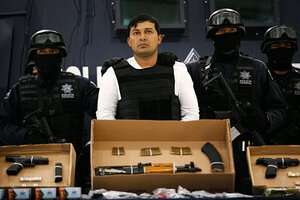Mexico nabs Zetas gang's No. 3 leader, but will it stop the cartel?
The arrest of Jesus Enrique Rejon Aguilar follows a series of recent drug-war gains by Mexico's government.

Suspect Jesus 'El Mamito' Rejon is presented by the police to the media in Mexico City on Monday. Rejon is thought to be a founding member and currently third in command of the Zetas, which was started by former Mexican special forces soldiers and is considered the country's most brutal cartel.
Bernardo Montoya/Reuters
As AFP reports, Jesus Enrique Rejon Aguilar was traveling in the company of a police officer escorting him to the southeastern state of Campeche when Federal Police detained him in Atizapan de Zaragoza, a Mexico City suburb of several hundred thousand people.
Authorities did not offer many details of the operation in which Mr. Rejon was arrested, but they said that no shots were fired.
Rejon defected from the elite army unite known as the GAFEs in the late 1990s to form the Zetas, a group of gunmen and bodyguards then at the service of Gulf Cartel boss Osiel Cardenas. Following Mr. Cardenas’s arrest in 2003 and extradition in 2007, the Zetas began to operate independently from their erstwhile bosses in the Gulf structure, and since 2010, the two groups have been locked into open warfare across much of Mexico.
Rejon is also sought by the United States government, and officials believe he may have had a role in the shooting death of Immigration and Customs Enforcement agent Jaime Zapata in February.
Alejandro Poire, the federal government’s security spokesman, said that Rejon was the third ranking member of Los Zetas, behind only Heriberto Lazcano and Miguel Angel Treviño.
The Rejon arrest follows a series of smaller triumphs by the government against the gang in recent weeks. Authorities in Hidalgo arrested a man they called the Zetas’ leader in Pachuca, the state’s biggest city, along with 12 other alleged subordinates in late June. On June 25, Federal Police announced the arrest of Albert Gonzalez Peña, the group’s boss in the key Gulf state of Veracruz.
Days later, an alleged Zetas operative accused of participating in a series of recent massacres in San Fernando, Tamaulipas was arrested in Veracruz as well.
Tough to beat
Poire said that of the original founders of the Zetas, only Lazcano remains, with all of the remainder either dead or in prison. But recent successes notwithstanding, any triumphant tone is a little out of place, because the Zetas remain one of the most dangerous gangs in Mexico, and it's not yet clear that the arrests have significantly limited their room to operate.
In fact, the government has been making similar claims for years, despite the steadily growing menace of the Zetas. The government has made similar comments for several years, as Luis Astorga detailed in his 2007 book, "Seguridad, Traficantes, y Militares." In 2006, for instance, El Universal reported, based on an army general’s comments, that the “Zetas are now just a myth.”
This dynamic of government pressure coupled with continuous rejuvenation demonstrates the adaptability of this group in particular, and of the Mexican drug trade in general.
Even having lost the majority of their elite founders, and a large portion of their initial reinforcements from the Mexican military (a group that includes Treviño), the Zetas have replenished their ranks, recruiting from local gangs in the cities where they operate. They have linked up with American gangs like the Mexican mafia and MS-13 so as to improve their capacity to vault drugs across Mexico’s northern border, and have retained much of their territory despite fighting with the Gulf Cartel.
Changing the game
Perhaps more than any other gang, the Zetas have also changed the business model for the Mexican criminal organization, branching out from drug trafficking and into extortion, kidnapping, and pirate merchandise. They have also spread from their initial turf in Mexico's northeast to the Yucatan Peninsula and parts of Mexico's Pacific coast region.
In addition, the Zetas have expanded internationally, becoming arguably the strongest gang in Guatemala.
There, the Zetas have deepened links with Guatemalan ex-military personnel known as Kaibiles, and have taken over key regions like Alta Verapaz and Peten, site of a recent massacre of dozens of laborers who worked for a rival of the Zetas.
All of this indicates that the Zetas are far more than just their founding members or leadership cohort, and even the capture of Lazcano and Treviño would likely not be enough to eliminate the group.
--- Patrick Corcoran is a writer for Insight – Organized Crime in the Americas, which provides research, analysis, and investigation of the criminal world throughout the region. Find all of his research here.
